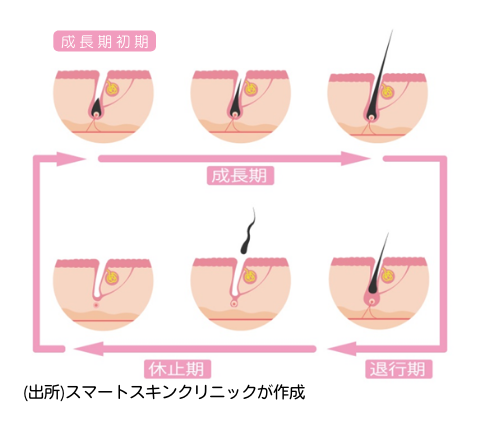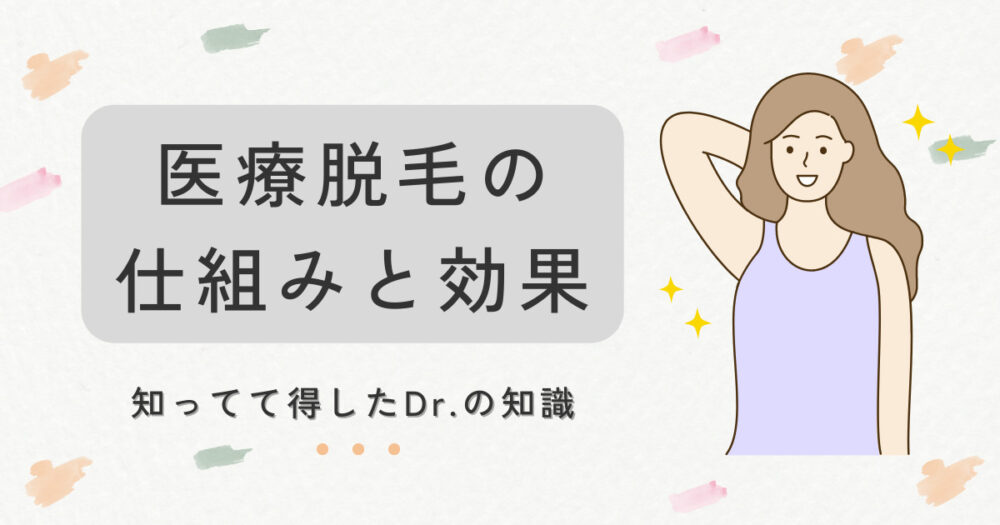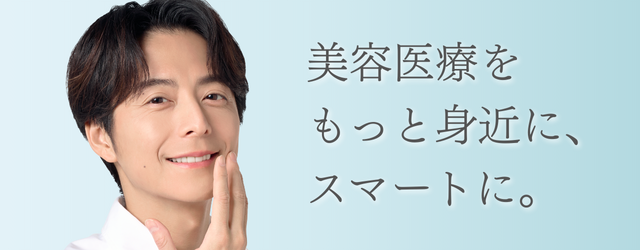Doctors explain] Is it true that medical hair removal is "ineffective"? Thorough and easy-to-understand explanation!
I've heard that even medical hair removal "doesn't work," but is that true?"
"I've had medical hair removal, but I feel it's 'ineffective'..."
I had one session of medical hair removal, and now the hair is growing back..."
Hello, I am a doctor at Smart Skin Clinic.
Do you have any of these problems or questions?
In conclusion, medical hair removal is properlyIt works."Treatment.
However, there are a certain number of people who have these concerns and questions.
In this article, we would like to explain in detail from a medical standpoint, along with the mechanism of medical hair removal, so that those who have such concerns and questions can resolve their anxiety.
Chairman of Smart Skin Clinic Group
stone Kouta
career
Graduated from Juntendo University School of Medicine
Tokyo Women's Medical University Hospital and related facilities
Worked at a major beauty clinic in Tokyo
Affiliation / Qualifications
Japan Surgical Society Specialist
Japanese Society of Anti-Aging Medicine
Is it true that "medical hair removal is ineffective?"
In conclusion, medical hair removal is effective.
The reason for this, I think, makes sense from a medical point of view.
The hair removal equipment used in medical hair removal destroys the "hair-growing tissue" and the "bulge region" of the target hair, which controls the growth and regeneration of hair.

Of course, without the hair-growing tissues necessary for hair growth, and without the signals that tell the hair-growing tissues to "grow hair," it makes sense that hairs would not be produced.
However, it is also true that there are those who feel that medical hair removal is ineffective and have concerns.
Why do you feel that way?
I will now try to clarify why people feel that medical hair removal is ineffective.
7 Factors and Reasons Why Medical Hair Removal is Ineffective
Why medical hair removal is said to be ineffective
Smart Skin Clinic's own research into the reasons for the perceived ineffectiveness of medical hair removal has revealed the following reasons.
...hairs remain after the treatment.
The hairs fell out once, but grew back from the same place.
I have had many treatments, but I don't feel that my hair is decreasing.
Some areas may feel the effects of hair removal while other areas do not.
In summary, it can be organized as follows
No hairs have fallen out."
"The hairs will grow back."
The hair removal effect is uneven in different parts of the body.
Seven factors of "no shedding," "re-growth," and "uneven hair removal effect.
Why do these allegedly ineffective events occur?
There are seven factors that I can speak from medical opinion and from my experience as a cosmetic dermatologist, which I have summarized below.
1. Hair removal equipment that is not appropriate for the hair type is not being used.
2. incorrect understanding of how medical hair removal works.
3. Interval between visits that does not take the hair cycle into consideration
4. Self-treatment using hair removers.
5. Output energy is insufficient or suppressed.
6. Irradiation leakage
7. The patient is receiving treatment with a cosmetic hair removal model instead of a medical hair removal model.
I will now go on to explain each of the seven factors, so please read what you are interested in.
1. Hair removal equipment that is not appropriate for the hair type is not being used.
At the clinic, a consultation is always held before the treatment is performed. At that time, we will confirm the hair and skin quality of the area where you wish to have hair removed, as well as the amount of hair you wish to have removed.
This confirmation is a necessary and very important process in order to select the appropriate hair removal equipment.
There are different types of medical hair removal equipment, such as "thermal destruction" and "heat storage" lasers, depending on the quality of the hair and the target to be destroyed.
There are also models such as "alexandrite laser," "diode laser," and "YAG laser" depending on the length of the wavelength of the light delivered, and the effective one should be selected according to the depth of the root of the hair.
Each model has its own characteristics, such as effective/ineffective hair type, and skin type that can be used/not used.
Depending on the area of the body, there are various types of body hairs, ranging from soft, lightly pigmented hairs like baby hair to thick, dark, deep-rooted hairs like those in the armpits and VIO.
Thus, based on the characteristics of the model and the characteristics of the hair type, it may be difficult to feel the effects of hair removal if the right model is not selected for the hair type.
Also, if the entire body is to be epilated with only one model, you may experience a difference in effectiveness in some areas.
2. incorrect understanding of how medical hair removal works.
Again, there are various models of medical hair removal, each with its own characteristics, advantages and disadvantages.
However, one thing in common is that no matter which model is used, hairs do not fall out immediately after irradiation.
It takes about 1 to 2 weeks for the thermal destruction type and 3 to 4 weeks for the heat storage type until the hairs are removed.
In addition, for effective hair removal, it is necessary to be aware of the hair cycle, the cycle of hair from birth to shedding.

Only hairs in the growth phase can be effective in hair removal. This is because only growing hairs are in contact with the hair-growing tissue or bulge area.
And the important thing to remember is that the hair cycle is different for different parts of the body and that each hair is in a different phase of the hair cycle, even if it grows on the same part of the body.
It is said that 20% of all hairs are now visible, and among the visible hairs, there are those in the growing phase and those in the regressing phase (not in contact with the hair-growing tissue or bulge area).
Conversely, there are hairs that are not visible to the eye, but are still newborn (early growth phase) under the skin.
The laser light reaches the target through hairs that are above the skin, so hairs that are not on the surface of the skin will grow back over time without being affected by the laser light.
Therefore, those who thought that hair removal would "fall out right away" or "never grow back" may feel that "it does not fall out" or "it grows back.
The hair cycle, especially on the face, is the shortest of all the body's hair cycles, one to two months.
Suppose that with facial hair removal, all visible hairs could be removed in one treatment.
However, it may be difficult to feel the effects of hair removal because the next hair grows back quickly.
That would mean that the perception was wrong in the first place.
3. Interval between visits that does not take the hair cycle into consideration
If the interval between visits is extremely short or longer than that specified during the counseling session, it will not coincide with the growth phase of the hair, and effective hair removal will not be possible.
As explained earlier regarding the hair cycle, it is important to have treatments at intervals that match the hair cycle in order to obtain the proper hair removal effect.
4. Self-treatment using hair removers.
As it relates to the hair cycle, self-treatment with a hair remover disrupts the hair cycle.
Even if the interval between treatments is set in consideration of the hair cycle, if the hair cycle is disrupted by self-treatment, it will be difficult to obtain the effect of hair removal.
5. Output energy is insufficient or suppressed.
With regard to the lack or suppression of output energy, there are several reasons.
Pigmented skin, tanned skin, dry skin
Because the laser reacts with melanin pigments in the skin, the output energy may be reduced to reduce the risk of burns and skin problems.
In order to effectively remove hair, the individual receiving the treatment must be prepared on a daily basis by taking care of his or her skin, including sun protection and moisturizing.
Those who experience a lot of pain or are undergoing treatment for the first time
If you feel a lot of pain, or if this is your first time having the procedure, we will start with a lower output to see how your skin reacts to the treatment.
Pain control methods can be handled with anesthesia creams, etc., so consult the clinic.
Areas with dense hair
This occurs because energy is distributed to each hair, resulting in a relative lack of energy.
6. Irradiation leakage
Hair removal may not be possible due to irradiation omissions.
A leakage of irradiation is just as the term implies: "the laser irradiation has been omitted, i.e., the laser was not applied".
It does not mean "ineffective," but rather that the laser was not irradiated in the first place, leaving the hairs in rows, or growing back, compared to the surrounding hairs. In case of irradiation failure, it is advisable to consult the clinic first.
7. The patient is receiving treatment with a cosmetic hair removal model instead of a medical hair removal model.
If the treatment is cosmetic hair removal (optical hair removal) rather than medical hair removal, it is difficult to feel the effects of hair removal.
This is because the expected effects of medical hair removal are completely different from those of optical hair removal at esthetic clinics.
Some beauty clinics use optical hair removal, so if you are concerned about the effectiveness of hair removal, it is a good idea to check with the clinic to see what model they use.
Understand how medical hair removal works.
We have discussed seven reasons why medical hair removal is said to be ineffective and the factors that contribute to this ineffectiveness.
From here, I will briefly explain how medical hair removal works so that you can better understand medical hair removal.
In conclusion, medical hair removal works by destroying the "hair-growing tissue" and "the part of the hair that controls the growth and regrowth of hair (the bulge region). This is how it works.

Without hair-growing tissue, which is the source of hair, and without a signal that tells the hair-growing tissue to "grow hair," hair cannot be produced.
Next, I will explain how the targeted hair-growing tissue or bulge area is destroyed.
The process by which the targeted hair-growing tissue or bulge area is destroyed is as follows
(1) When laser light is irradiated on hair, it is absorbed by the melanin pigment of the hair
(2) Absorbed light energy is converted to heat energy to destroy the target.
In this process, the target is destroyed and hairs are no longer grown.
If you would like to know more about the detailed mechanism and models of medical hair removal, please read this article as well.

summary
In this article, we have discussed seven factors that explain why people say that medical hair removal is ineffective and why.
If you felt "ineffective," did any of these apply to you?
Medical hair removal can be very effective when done properly.
Smart Skin Clinic is a medical institution and uses medical hair removal machines approved by the Ministry of Health, Labor and Welfare.
If you are interested in undergoing medical hair removal or would like to discuss medical hair removal, please feel free to contact us at Smart Skin Clinic.




